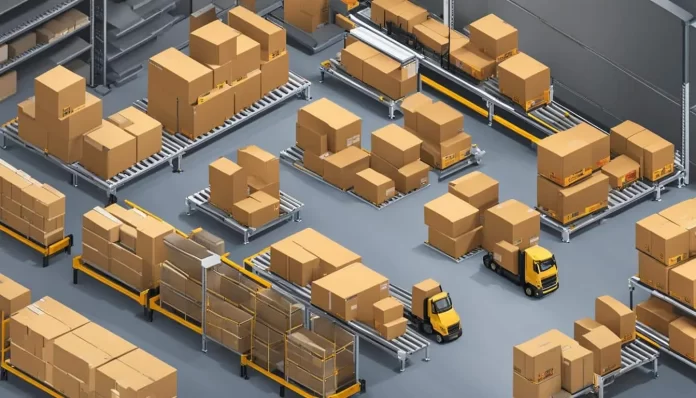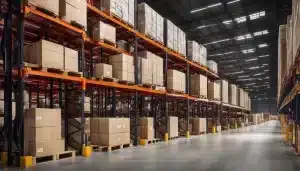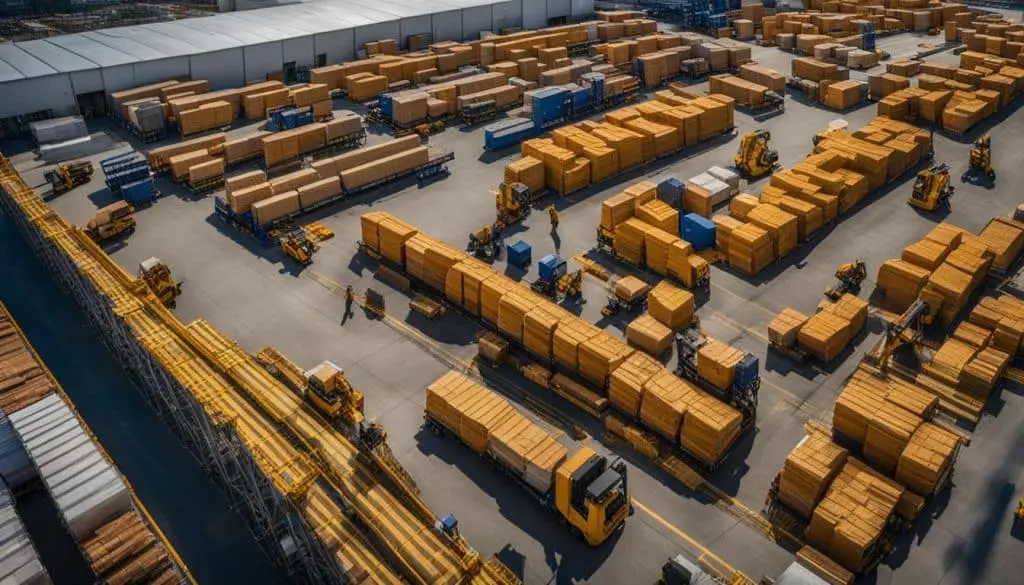Streamlining your logistics operations is crucial for the success of your business. By optimizing your logistics processes, you can improve distribution efficiency, reduce shipping costs, and enhance customer satisfaction. One effective way to achieve logistics optimization is by utilizing a fulfillment warehouse.
A fulfillment warehouse plays a critical role in streamlining your order processing and improving overall supply chain management. It provides you with the infrastructure and expertise to efficiently manage your inventory, pick and pack orders, and ensure timely delivery to your customers. With the help of a fulfillment warehouse, you can streamline your logistics operations and focus on growing your business.
To learn more about the importance of a fulfillment warehouse and its impact on streamlining logistics and achieving distribution efficiency, continue reading our article. We will discuss how a fulfillment warehouse can optimize your logistics processes and help you achieve your business goals.
Table of Contents

The Critical Role of a Fulfillment Warehouse in Ecommerce Success
A well-optimized fulfillment warehouse is a crucial component of achieving ecommerce success. By streamlining order processing and operations, a fulfillment warehouse plays a vital role in meeting customer expectations and maximizing efficiency.
One of the key functions of a fulfillment warehouse is managing inventory effectively. With the ability to track stock levels accurately, businesses can ensure that products are always available for order fulfillment. This ensures that customers can find and purchase the items they want, leading to increased customer satisfaction and repeat business.
In addition to inventory management, a fulfillment warehouse excels in the fulfillment aspect of ecommerce operations. With streamlined order processing, businesses can pick, pack, and generate delivery notes with speed and accuracy. This enables quick dispatch and delivery, which is essential for meeting today’s fast-paced consumer demands.
Timely delivery is a critical factor in customer satisfaction and repeat purchases. With a fulfillment warehouse’s optimized operations, businesses can ensure that their products reach customers in a timely manner, enhancing their overall shopping experience. Meeting delivery expectations fosters customer loyalty and positive brand perception, ultimately contributing to ecommerce success.
Furthermore, a well-optimized fulfillment warehouse enables businesses to achieve streamlined operations. By leveraging efficient processes and the right technology, such as barcode scanning and advanced inventory management systems, businesses can minimize errors, reduce costs, and enhance overall productivity. This translates to improved order accuracy, reduced return rates, and increased operational efficiency, all of which are crucial for long-term success in the ecommerce industry.
In summary, a fulfillment warehouse plays a critical role in ecommerce success by streamlining order processing, managing inventory effectively, and ensuring timely delivery to customers. With the ability to pick and pack orders with speed and accuracy, businesses can meet customer expectations and enhance operational efficiency. By optimizing these key aspects, businesses can position themselves for growth, scalability, and profitability in the ecommerce landscape.
When to Consider Upgrading to a Professional Fulfillment Warehouse
Upgrading to a professional fulfillment warehouse can be a strategic decision for businesses looking to enhance their logistics operations. As your business grows, it’s crucial to evaluate when it is the right time to consider upgrading to a professional fulfillment warehouse. There are several factors to consider:
Increased Order Volumes: If your business is experiencing a significant increase in order volumes, a professional fulfillment warehouse can efficiently handle the growing demand. With their expertise and specialized systems, professional warehouse services can handle higher order volumes without compromising on order accuracy or delivery speed.
Expanding Market Reach: When your business expands its market reach, reaching customers in new regions and countries, it is essential to have a fulfillment warehouse strategically located to optimize order fulfillment. A professional fulfillment warehouse can offer regional distribution ERP centers, reducing shipping costs and transit times for your customers.
Specialized Services: If your business requires specialized services such as custom packaging, kitting, or product customization, upgrading to a professional fulfillment warehouse is crucial. Professional warehouse services have the expertise, infrastructure, and equipment to handle specialized requirements, ensuring your products are packed and delivered according to your specifications.
By evaluating these factors and considering the scalability of your logistics operations, you can determine if upgrading to a professional fulfillment warehouse is necessary for your business’s growth and success.
Optimizing Warehouse Layout for Streamlined Order Processing
Warehouse layout optimization is a critical factor in achieving streamlined order processing and efficient inventory management. By strategically organizing your warehouse, you can maximize operational efficiency, reduce errors, and improve overall order processing speed.
Proper inventory organization is a key consideration in warehouse layout optimization. Categorizing and labeling inventory in a logical and consistent manner ensures that products can be easily located and picked for orders. This minimizes time spent searching for items and reduces the chances of picking errors.
An efficient flow pathway within the warehouse is also vital for streamlined order processing. By designing a layout that minimizes unnecessary movement and maximizes the flow of goods, you can optimize the picking, packing, and shipping processes. This improves overall productivity and reduces handling time.
Utilizing technology and automation is another important aspect of warehouse layout optimization. Implementing barcode scanning systems, automated conveyor belts, and robotic picking systems can significantly enhance order processing efficiency. These technologies reduce manual labor, increase accuracy, and expedite the fulfillment process.
To illustrate the significance of warehouse layout optimization, consider the image below:
The image showcases a well-organized warehouse layout, with clearly marked storage areas, efficient flow paths, and automated systems in place. Such a layout enables businesses to streamline their order processing, minimize errors, and ensure timely delivery to customers.
By optimizing your warehouse layout for streamlined order processing, you can enhance efficiency, reduce costs, and improve customer satisfaction. Take the necessary steps to organize your inventory effectively, optimize flow pathways, and leverage technology and automation. These strategies will help you achieve a highly efficient and productive warehouse operation.
Understanding the Impact of On-Demand Warehousing
On-demand warehousing is revolutionizing the logistics industry by offering flexible storage solutions for businesses. This innovative approach allows companies to adapt their inventory management according to fluctuating demand and dynamic market conditions. With on-demand warehousing, you have the ability to scale your storage capacity as needed, reducing the risk of overstocking or understocking.
One of the key benefits of on-demand warehousing is cost savings. Instead of investing in a fixed warehouse space, you can leverage the on-demand model to pay for storage only when you need it. This not only reduces your overhead costs but also provides the flexibility to allocate your resources more strategically.
Scalability is another advantage of on-demand warehousing. As your business grows and expands into new markets, you may require additional storage space to accommodate the increased inventory. On-demand warehousing enables you to seamlessly scale your storage capacity without the need for long-term commitments, allowing you to adapt to changing business needs.
Implementing on-demand warehousing services can optimize your inventory management, ensuring that you always have the right amount of stock available. With real-time visibility into your inventory levels, you can minimize stockouts and avoid excess inventory. This level of inventory scalability helps you meet customer demands efficiently and maintain a high level of customer satisfaction.
Integrating Eco-Friendly Practices into Warehouse Operations
As the demand for sustainable logistics and green supply chains continues to grow, it is crucial for businesses to prioritize eco-friendly practices in their warehouse operations. By integrating these practices, businesses not only contribute to a healthier environment but also reap benefits such as improved brand reputation and attracting environmentally-conscious customers.
One of the key strategies for eco-friendly warehouse practices is implementing energy-efficient lighting. By replacing traditional lighting with LED fixtures, businesses can significantly reduce energy consumption and carbon emissions. This not only lowers operating costs but also contributes to a greener and more sustainable warehouse environment.
Another essential aspect of sustainable logistics is waste reduction. Implementing waste management programs such as recycling and composting can effectively minimize the amount of waste sent to landfills. Businesses can provide designated areas for recycling bins and composting stations, ensuring that materials such as cardboard, plastic, and organic waste are properly sorted and disposed of in an environmentally-friendly manner.
Furthermore, adopting sustainable packaging materials is crucial for companies looking to minimize their environmental impact. Utilizing biodegradable or recyclable packaging solutions not only reduces waste but also aligns with consumer expectations for eco-friendly practices. Businesses can explore options such as compostable packaging, recyclable plastics, or even innovative materials made from renewable resources.
By integrating eco-friendly practices into warehouse operations, businesses can contribute to the creation of a green supply chain. This demonstrates their commitment to sustainability and positions them as leaders in responsible business practices. Moreover, adopting eco-friendly practices can lead to cost savings in the long run, as operating efficiency improves and waste management expenses decrease.
In conclusion, adopting eco-friendly warehouse practices plays a vital role in building a sustainable logistics ecosystem. By implementing strategies such as energy-efficient lighting, waste reduction programs, recycling initiatives, and sustainable packaging, businesses can reduce their environmental footprint and improve their brand reputation. Embracing eco-friendly practices not only benefits the environment but also positions businesses as leaders in the industry, attracting environmentally-conscious customers. By taking these steps, businesses can contribute to a greener future while optimizing their warehouse operations.
The Synergy Between Distribution Centers and Cross-Docking Techniques
Optimizing supply chain efficiency is paramount for businesses seeking to streamline their logistics operations. Distribution centers and cross-docking techniques play an integral role in achieving this goal. By exploring the synergy between distribution centers and cross-docking, businesses can unlock various benefits and enhance their supply chain performance.
Cross-docking techniques encompass various practices, including just-in-time delivery, consolidation, and deconsolidation. Just-in-time delivery allows for the seamless transfer of products from incoming shipments to outbound transportation, without the need for additional storage. Consolidation involves combining multiple smaller shipments into larger ones to optimize transportation efficiency. On the other hand, deconsolidation allows for the separation of larger shipments into smaller ones to meet specific customer requirements.
By implementing cross-docking techniques, businesses can significantly streamline their supply chain and achieve notable benefits. These include reducing inventory holding costs, minimizing storage space requirements, and improving order fulfillment speed. Cross-docking enables businesses to optimize their inventory management by facilitating the movement of goods through distribution centers with minimal intermediate handling and storage.
Distribution centers act as key hubs in the cross-docking process. They serve as strategic locations for receiving, sorting, and temporarily storing products before onward distribution. Distribution centers play a critical role in coordinating the flow of goods, ensuring timely deliveries, and facilitating cross-docking operations.
The benefits of incorporating distribution centers and cross-docking strategies into the supply chain extend beyond improved efficiency. Businesses gain greater agility in responding to changing market demands and customer expectations. This enables them to optimize their inventory levels, prevent stockouts, and enhance overall customer satisfaction.
Furthermore, the synergy between distribution centers and cross-docking contributes to cost savings. By reducing the need for intermediate storage and minimizing transportation distances, businesses can lower their operating expenses and achieve higher profit margins.
In conclusion, distribution centers and cross-docking techniques play a pivotal role in optimizing supply chain efficiency. By leveraging the benefits of cross-docking, such as reduced inventory holding costs and improved order fulfillment, businesses can streamline their logistics operations. Incorporating distribution centers enhances the coordination of cross-docking activities and enables businesses to respond effectively to changing market demands. Together, distribution centers and cross-docking strategies contribute to a more efficient and cost-effective supply chain.
Choosing a Warehouse Management System for Your Fulfillment Warehouse
When it comes to maximizing the efficiency of your fulfillment warehouse, choosing the best warehouse management system (WMS) is crucial. A WMS is a software solution that helps businesses automate and streamline their warehouse operations, resulting in improved inventory visibility and enhanced overall logistics performance.
When selecting a WMS for your fulfillment warehouse, there are several key considerations to keep in mind:
Functionality: Make sure the WMS has the necessary features to meet your specific warehousing needs. It should be capable of managing inventory, tracking orders, optimizing storage space, and facilitating efficient order fulfillment software.
Scalability: Your business may grow, and so should your WMS. Choose a system that can accommodate your future expansion and handle increased order volumes without compromising performance.
Integration capabilities: Ensure that the WMS can seamlessly integrate with your existing technology stack, such as your e-commerce platform, ERP system, and transportation management system. This integration will enable data synchronization and streamline your end-to-end logistics operations.
User-friendliness: A user-friendly interface and intuitive navigation are essential for effective WMS adoption. Look for a system that is easy to learn and operate, minimizing training time for your warehouse staff.
By carefully considering these factors, you can choose a WMS that aligns with your fulfillment warehouse requirements and supports your logistics technology infrastructure.
With the right WMS, you can unlock new levels of efficiency and productivity. To maximize the benefits, consider the total cost of ownership and get a clear picture of your costs to discover the value our WMS can bring.
Leveraging Technology for Enhanced Warehouse Productivity
Technology has revolutionized the way warehouses operate, offering businesses various solutions to optimize their warehouse productivity. By embracing these technological advancements, you can improve operational efficiency, streamline processes, and ultimately enhance your overall warehouse performance.
One key technology solution that can significantly boost warehouse productivity is automation systems. Automation can streamline labor-intensive tasks, such as inventory management, order processing, and packing. By automating these processes, you can minimize errors, increase speed, and reduce operational costs.
Robotics is another cutting-edge technology that can transform your warehouse operations. Robotic systems can enhance picking and packing processes by efficiently navigating through the warehouse, accurately locating and retrieving items, and packaging orders. This not only speeds up order fulfillment but also improves accuracy and reduces manual labor.
AI-powered inventory management systems are also invaluable in optimizing warehouse productivity. These systems utilize artificial intelligence algorithms to analyze historical data and predict demand patterns. With real-time inventory visibility and accurate demand forecasting, you can optimize stock levels, improve stock replenishment processes, and reduce both stockouts and overstock situations.
Real-time tracking solutions play a vital role in warehouse productivity by providing accurate and up-to-date information about your inventory. With the ability to track and trace items in real-time, you can streamline the picking, packing, and shipping processes, reducing delays and ensuring efficient order fulfillment.
By leveraging technology solutions like automation systems, robotics, AI-powered inventory management, and real-time tracking, you can unlock significant improvements in warehouse productivity. Embracing these advancements allows you to accelerate order processing, reduce manual errors, optimize inventory management, and ultimately enhance your overall warehouse operations.













































